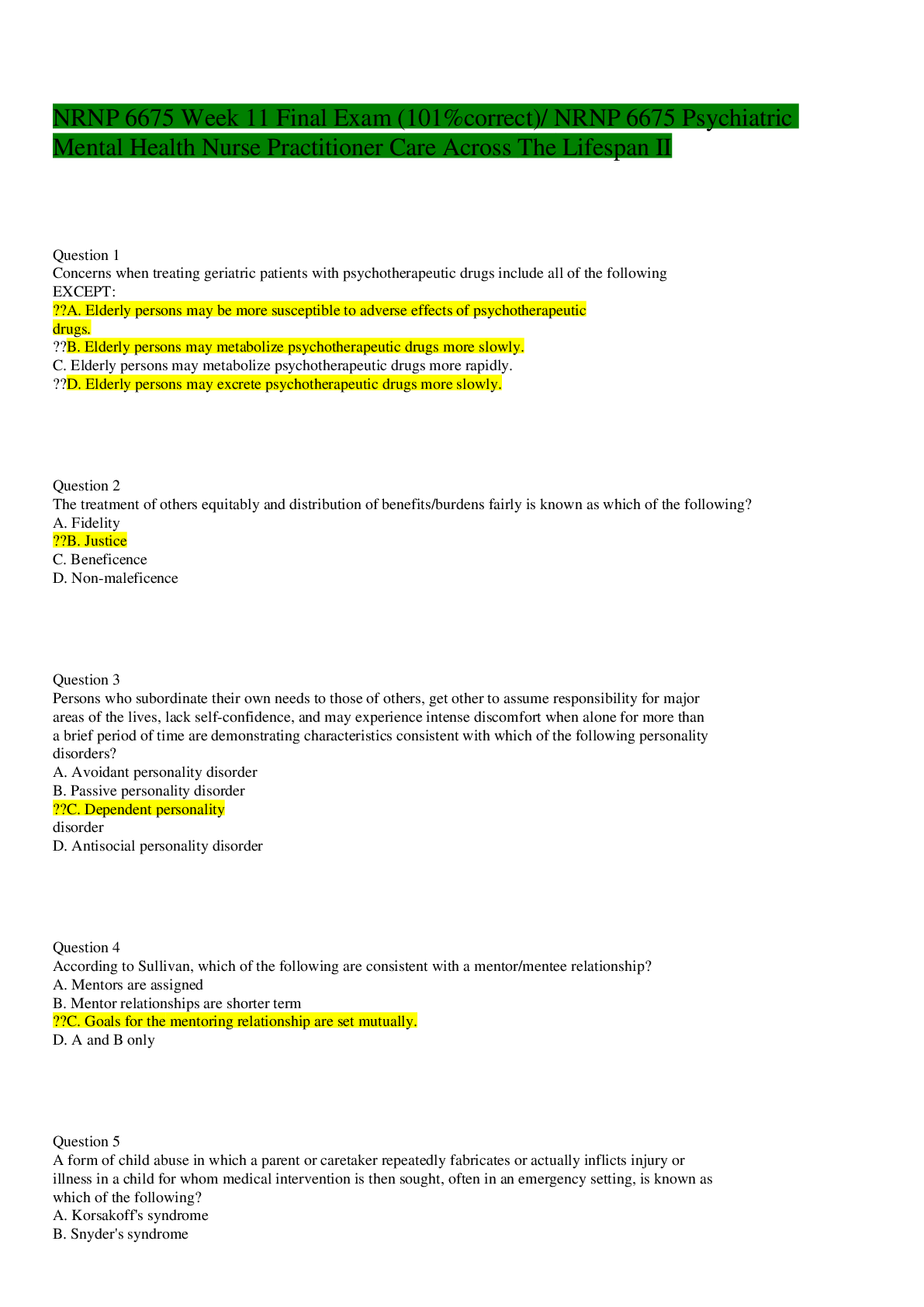*NURSING > EXAM > NURS 6660 Psychiatric Mental Health Nurse Practitioner Role I: Child and Adolescent. Walden Universi (2019)
NURS 6660 Psychiatric Mental Health Nurse Practitioner Role I: Child and Adolescent. Walden University
Document Content and Description Below
1. The PMHNP is evaluating a 15-year-old male patient who has been referred by his courtappointed guardian. He has been in foster care for the last 6 years and maintained a steady pattern of low-level... behavior problems such as skipping school and ignoring curfew. He is not openly defiant and has always been described as a ―loner.‖ He just does not follow most rules. During the mental status examination, the PMHNP notes that his expressions are sometimes inconsistent with the topic of conversation, and he does not seem to be able to transition effectively among levels of emotion. This represents an abnormality in: 2. A variety of diagnostic instruments are available to assist the PMHNP with comprehensive data collection. Which of the following tools is considered an ―interviewer-based‖ tool designed as a guide to clinicians designed to help clarify answers to questions? 3. Kevin is a 15-year-old male who presents for court-ordered psychiatric assessment. Kevin comes to his first appointment with both of his parents. He is sitting in the chair with his arms crossed and responds with ―yes‖ and ―no‖ answers to direct questions; otherwise, he volunteers no information. The parents are clearly upset and indicate they just ―don't know what to do with him anymore.‖ The most appropriate action for the PMHNP would be to: 4. The PMHNP observes separation from and reunion with the parent as part the mental status exam of a 25-month-old toddler. Extremes of emotion during separation or reunion are most consistent with: 5. The PMHNP is performing an emergency assessment on Renee, a 9-year-old girl who was initially brought to the attention of social services by her maternal grandmother. Renee is reluctant to talk about herself or her home life. The physical examination that accompanied this emergency assessment revealed a variety of ecchymoses in various stages of healing, and the examiner was suspicious that there was a history of sexual abuse. Renee is quiet and passive during the interview, but is rather aggressive when playing with dolls. While considering the need for removal from the home, the PMHNP knows that all the following are risk factors for predictors of further abuse and maltreatment except: 6. Harmony is a 4-year-old female who has been through several evaluations for behavioral abnormalities that have become increasingly disruptive, and the family is concerned for the safety of both Harmony and her 2-year-old brother. Comprehensive assessment of Harmony includes neuropsychiatric testing. The PMHNP documents the presence of neurological hard signs. These suggest: 7. During the mental status exam of Oliver, a 4-year-old child, the PMHNP appreciates that he appears to be having transient visual and auditory hallucinations. The PMHNP knows that the best approach to this finding is to consider that: 8. The PMHNP has been retained by the local school board to provide comprehensive counseling and guidance following an episode of tragic school violence. A 9th grader, acting alone, brought a gun into the school, fatally shooting a teacher and injuring four other teachers and students before he was subdued. In an effort to promote best healthy practices after this traumatic event, the school board is asking for advice on how to best manage the students. The PMHNP knows that the immediate priority must be: 9. Jenny is a 5-year-old female who has been referred for consultation because the emergency room physician suspects that she might be subject to physical abuse in the home. On evaluation, the PMHNP finds Jenny to be fearful, docile, and guarded. Although clearly in pain, Jenny seems surprised when the PMHNP attempts to provide some comfort. The PMHNP notes that: 10. Kelly is an 8-year-old girl who is being evaluated by the PMHNP because she is markedly behind her peers in school performance. During her mental status examination, she is unable to repeat three objects after five minutes, and is unable to repeat five digits forward or three digits backward. Further evaluation reveals an inability to add single digits. The PMHNP interprets this finding as: 11.Richard is an 11-year-old patient who has been hospitalized following a suicide attempt in which he mixed a variety of household cleansers and poisons and swallowed them. He has been medically cleared, and his initial psychiatric assessment reveals a preadolescent male who made this suicide attempt because he was so unhappy at school. His family recently moved from another part of the country and he started a new school. The other children have been bullying him, and he just decided it would be better to die. He has no siblings and no friends in this new town. Which additional findings during this assessment would prompt the PMHNP to suggest a psychiatric admission? 12. The PMHNP is discussing autism spectrum disorder (ASD) treatment strategies with the parents of 4-year-old Jeffrey. He is nonverbal and has been completely unable to adapt to any changes of environment; an effort to put him in a preschool class was what precipitated his evaluation and eventual diagnosis. At this point, Jeffrey's parents are very committed to doing anything necessary to support Jeffrey's growth and development and promotion of prosocial behavior. While developing his plan of care, the PMHNP suggests: 13. The PMHNP is writing an article to increase awareness among pediatric primary care providers to those factors that may suggest higher than average risk for the development of childhood anxiety disorders. It is helpful to note that which of the following are neurophysiologic correlates between young children and anxiety disorders? 14. The PMHNP is evaluating the data he has collected in the assessment of Anna, a 9-yearold girl who presented for evaluation because her teacher strongly encouraged Anna's mother to seek care. According to the teacher, Anna has been consistently disruptive in the classroom since the beginning of the school year, 2 months ago. The assessment includes unstructured interviews with Anna, her mother, and grandmother, and Connors Parent or Teacher Rating Scale for ADHD completed by her primary school teacher and mother. The PMNHP notes a marked disparity among reports—they all seem to contradict each other. The PMHNP considers that this apparent contradiction: 15. The PMHNP is evaluating 12-year-old Dale after the police were called to the home. Dale is assessed as having a psychotic episode; he tells the NP that voices are telling him that he is bad and that he should hurt himself. According to the mother, he has no history of psychiatric disease, medications, or really any concerns at all. Mom says he goes to school, has friends, and has always seemed ―normal.‖ An interview with his 13-year-old sister reveals that while there is no long-term history of abnormal behavior, for the last couple of weeks things have been very strange at home. His father has been arrested for ―something to do with a teenage girl,‖ and their parents have been fighting. His father lost his job, and there is a lot of talk about money and lawyers and jail. Dale has been very emotional as he has always been close to his Dad; he seems to go from crying to laughing in a blink, and is getting in fights at school. Even now, after he has calmed a bit, Dale's reality testing is altered. The PMHNP considers that Dale is demonstrating: 16. The PMHNP is providing counseling for the family of a 6-year-old girl who was recently adopted. This girl reportedly was removed from a home in which she was subjected to severe, long-term abuse in all forms: neglect, physical abuse, sexual abuse, malnutrition, and neglect of all medical care. Upon her rescue, which was incidental during a drug raid on the home, she was hospitalized for over 1 month for physical maintenance, nutrition, hydration, and treatment for a variety of infections, including sexually transmitted diseases. The adoptive family is very committed to providing a healthy environment and is very receptive to long-term individual and family therapy. The PMHNP discusses with the new parents and siblings that which of the following is most often linked to this type of history: 17. Comprehensive psychiatric/mental health assessment of children includes an interview with the parents or caregivers. Which of the following is not a true statement with respect to the parental interview? 18. Wendy is a 6-year-old female being evaluated by the PMHNP following a suicide attempt. The police were called when a neighbor saw Wendy jump out of the open window of her first-floor apartment. She was unhurt, but when the neighbor asked why she jumped out she said she wanted to kill herself. Which coincident finding would warrant an inpatient psychiatric admission for Wendy? 19. Psychiatric assessment of the adolescent patient is different in several ways from assessment of younger children. While trying to establish a therapeutic environment with an adolescent who is openly hostile, one of the most important things the PMHNP can do is to: 20. Having child and adolescent patients rate their feelings and moods on a scale of 1-10 is most effective in which age group? 21. Which of the following is a true statement with respect to developmental testing in infants? 22. Which of the following is a true statement with respect to crisis intervention and psychological debriefing as a preventive strategy for post-traumatic stress disorder (PTSD)? 23. Evaluation of psychiatric emergencies in children must include: 24. Melanie is a 13-month-old female who has been referred by her primary care pediatrician. She has not had consistent well-child checks, and at her first visit with this pediatrician at age 1 year, there was a notable absence of verbal babbling, interactive play, or smiling. Comprehensive assessment of Melanie must include all the following except: 25. Brian is a 13-year-old boy who presents for care. He was initially brought in by his mother after a family friend suggested mental health evaluation. Brian has been suffering with a variety physical symptoms for the past 8 months, ever since school started. He has missed so much school that he is in danger of not advancing to the eighth grade. He persistently complains of headache, stomachache, nausea, and dizziness. He has even vomited on more than one occasion, so his mother knows something is ―really wrong.‖ The pediatrician has been unable to identify a cause of symptoms or offer any relief. During his interview, the PMHNP learns that this is Brian's first year in middle school. There are hundreds of students, and it is much larger than the intimate elementary school Brian attended from kindergarten through sixth grade. Brian is certain that all the students are making fun of him; he does not even go to the lunchroom to eat. He has stopped socializing with his small group of friends from elementary school because they have made friends among the other seventh graders. Brian says he wants to have friends, but he just gets nervous and he is sure they will all make fun of him. Brian enjoys ―hanging out‖ with his cousins, and they spent the week of spring break playing at his house. But, when it was time to go back to school, Brian was so nauseous he could not attend. Initial treatment for Brian should include: 26. Phillip is a 5-year-old boy who is in care after being referred for failure to speak at school. He has been in kindergarten for 5 months, and initially his teacher thought he was just shy, so she did not focus on him. However, it has become increasingly apparent that he flat out will not speak at school. Phillip's parents are adamant that there is not any problem at home and that Phillip talks with them and his older sister routinely. Further assessment reveals that he has always been extremely shy and that he doesn't like it when people make a fuss over him. The PMHNP suspects that Phillip has selective mutism, which is closely related to: [Show More]
Last updated: 1 month ago
Preview 1 out of 10 pages
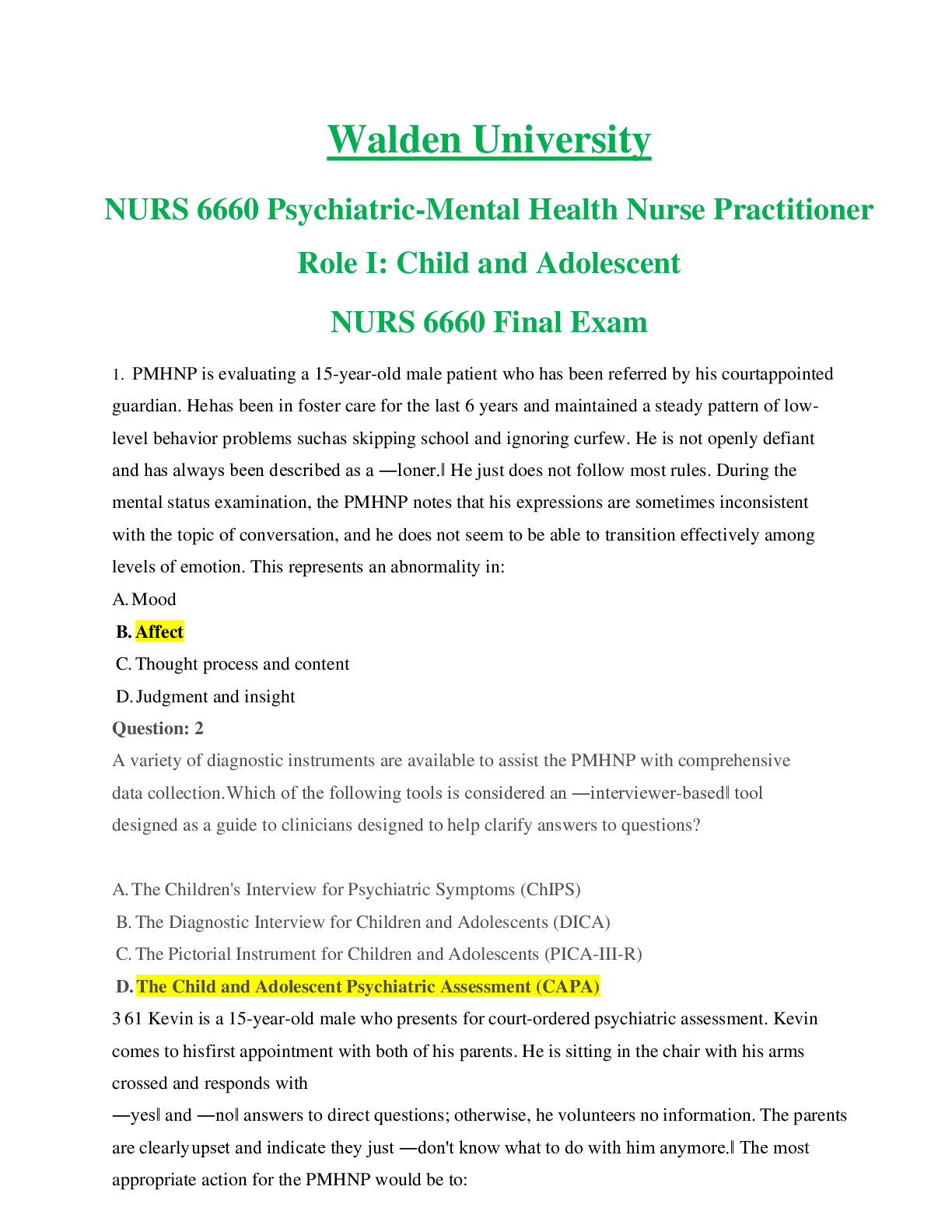
Reviews( 1 )

by eph · 3 years ago
Document information
Connected school, study & course
About the document
Uploaded On
Sep 18, 2019
Number of pages
10
Written in
Additional information
This document has been written for:
Uploaded
Sep 18, 2019
Downloads
6
Views
555

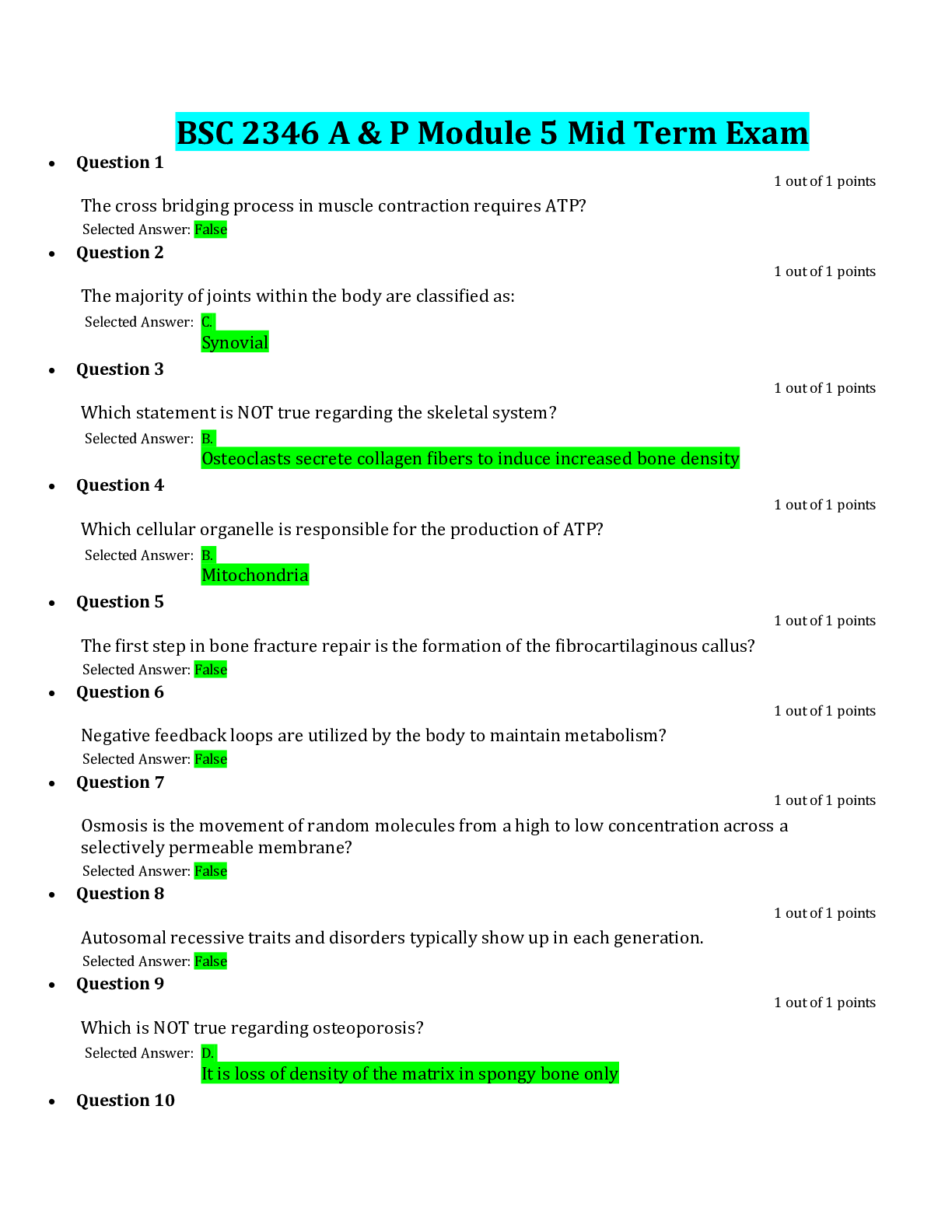
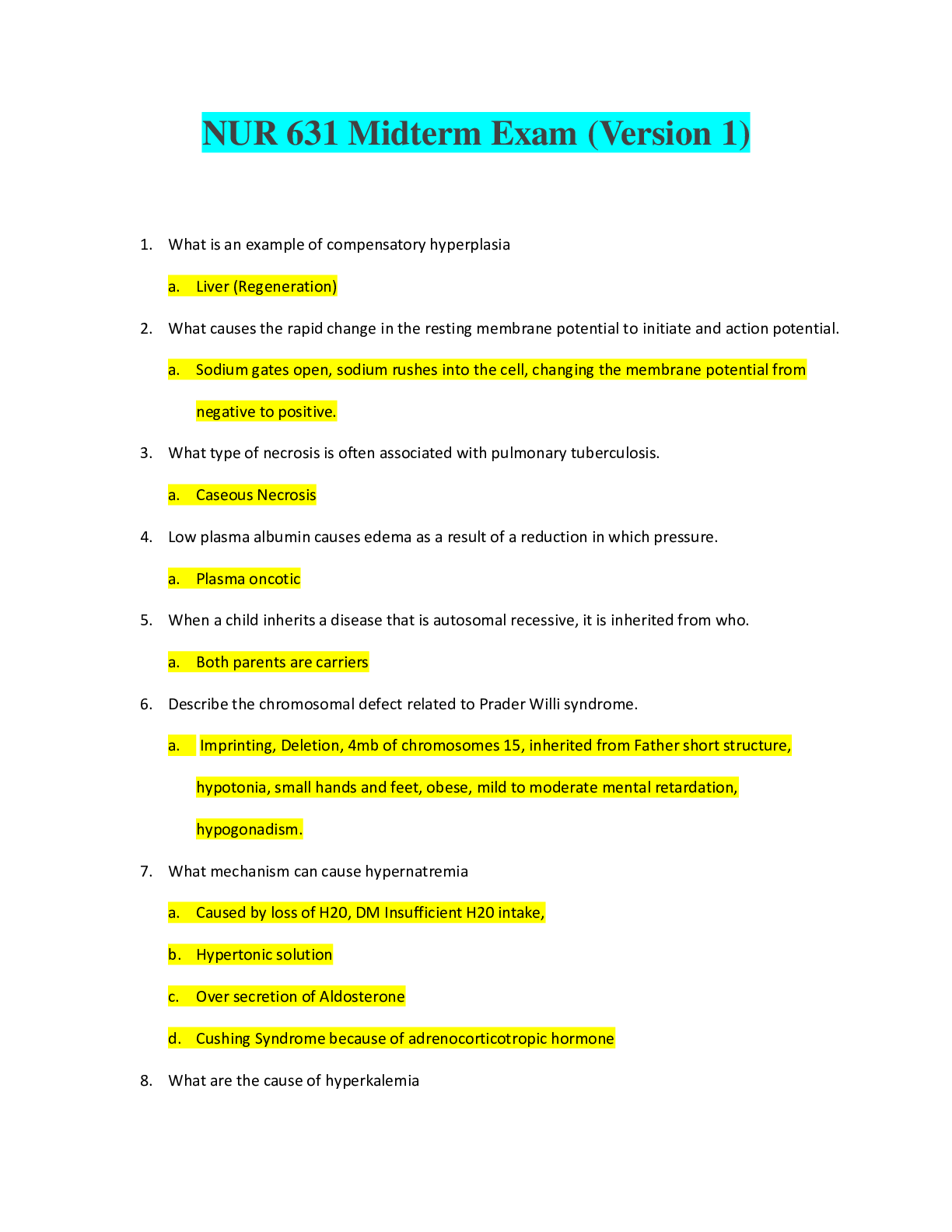


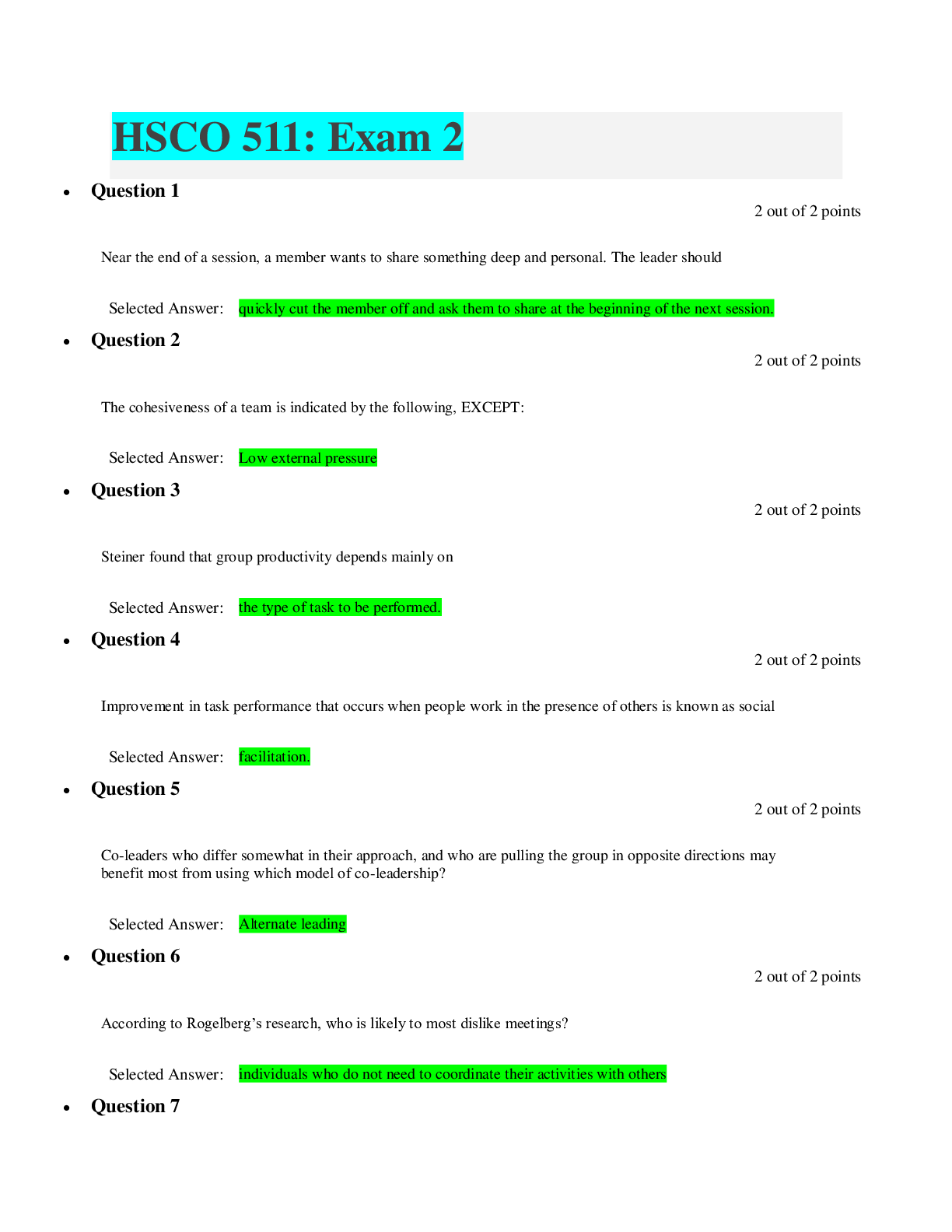
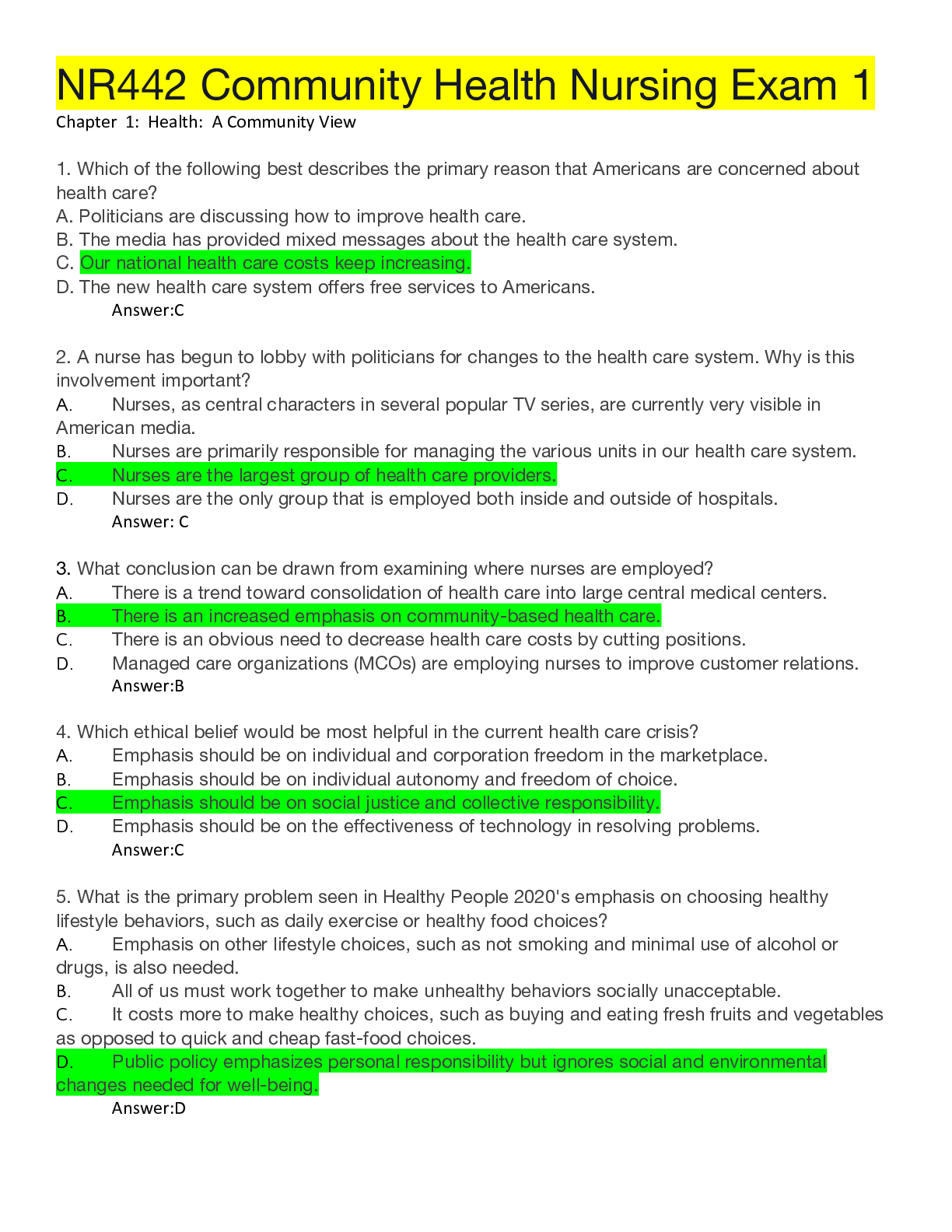
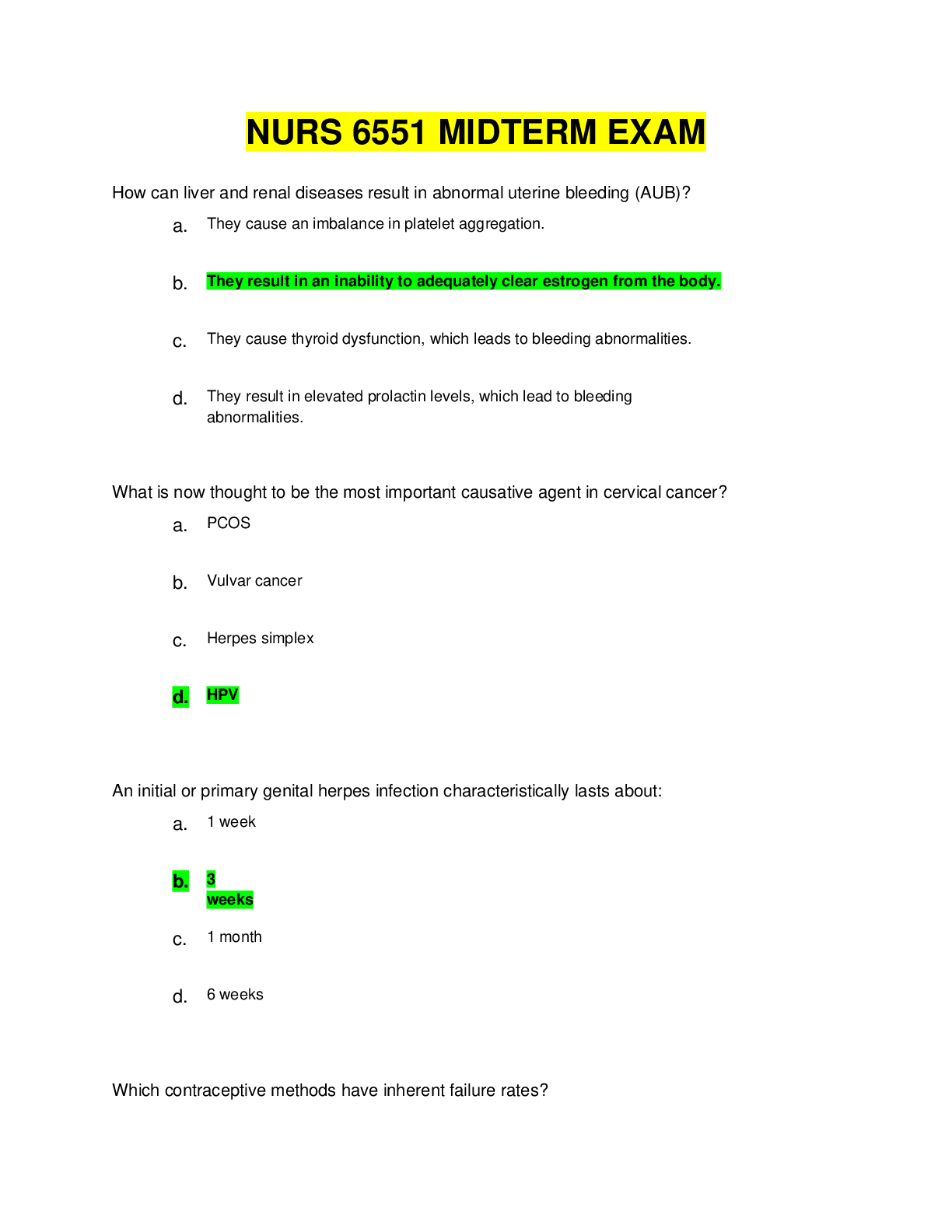


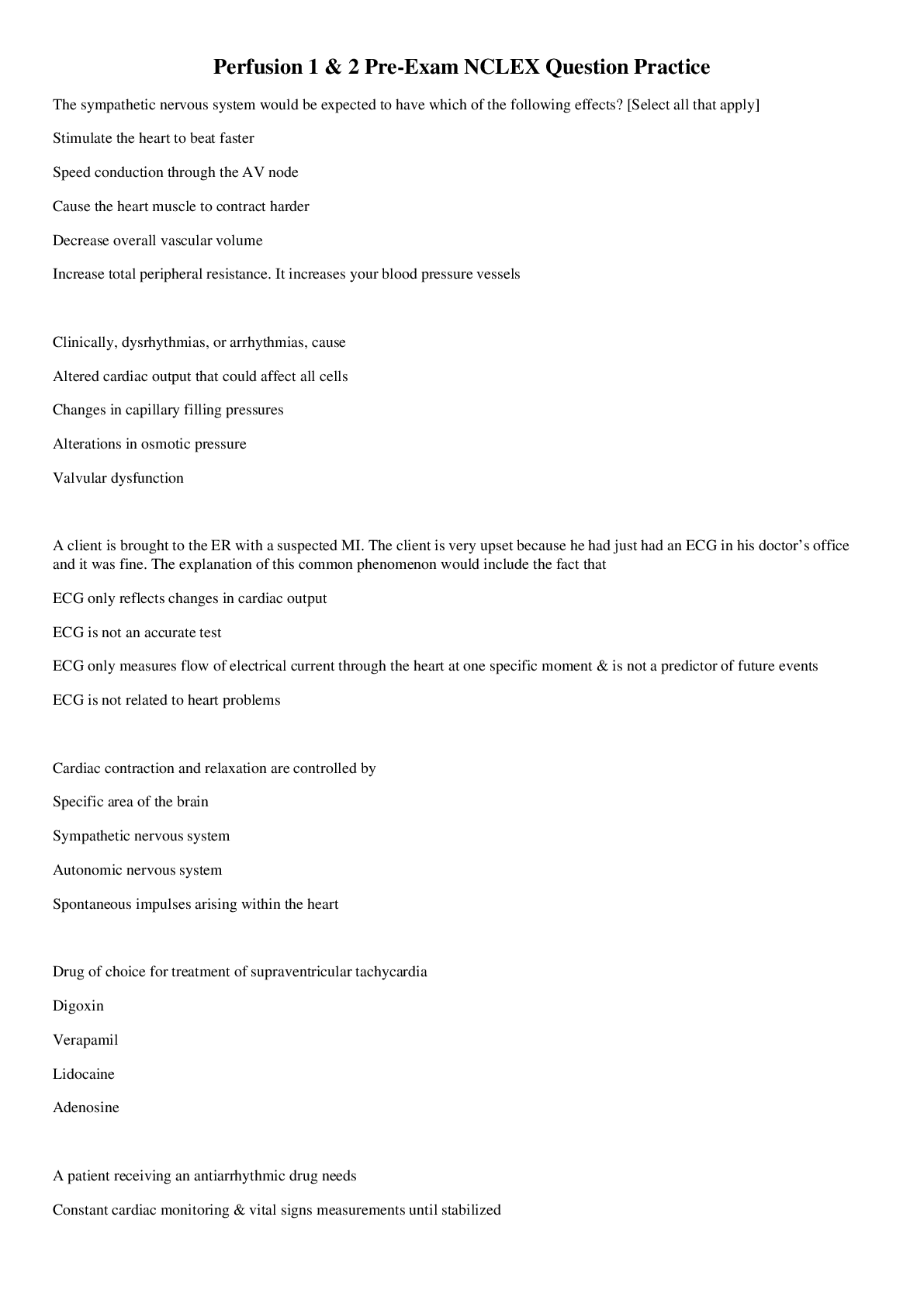
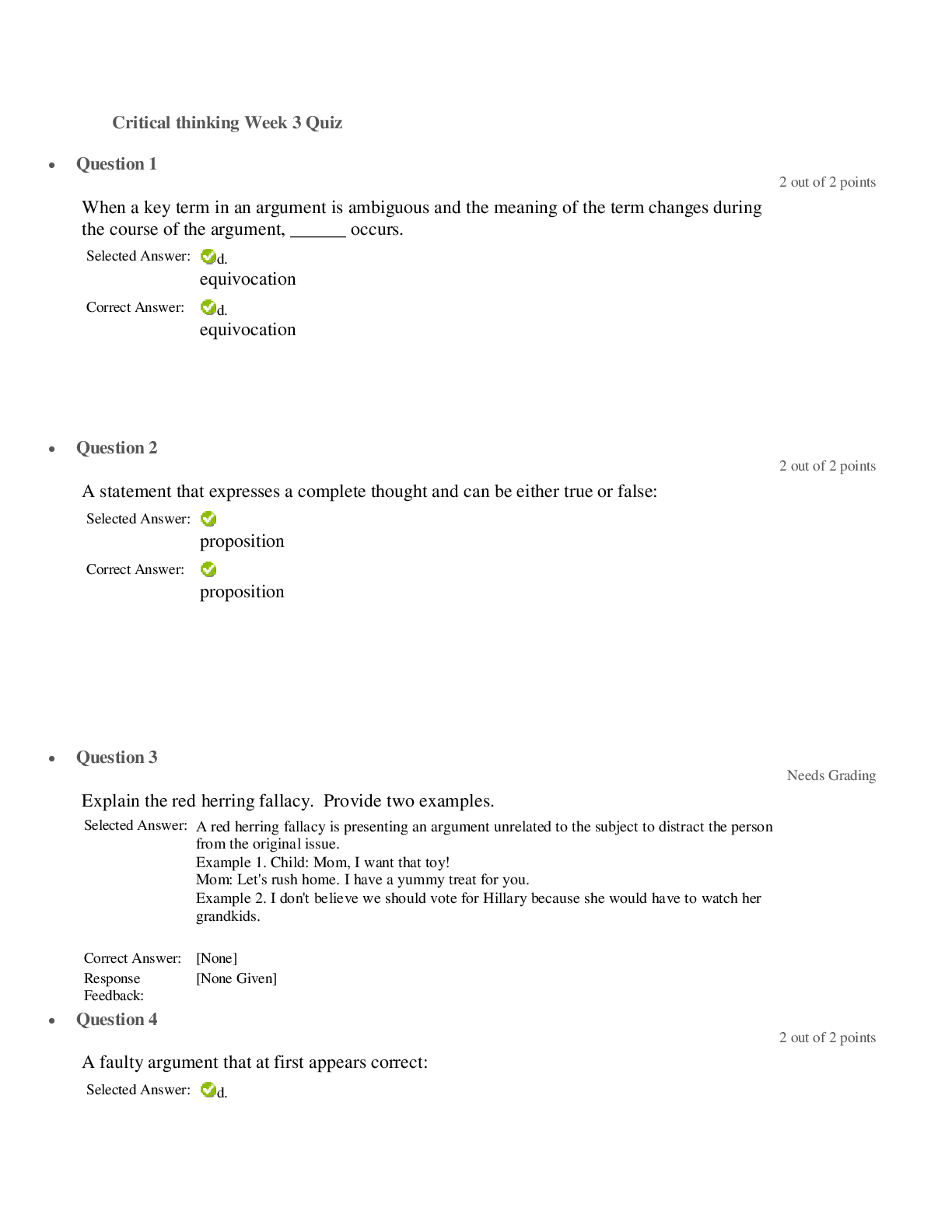


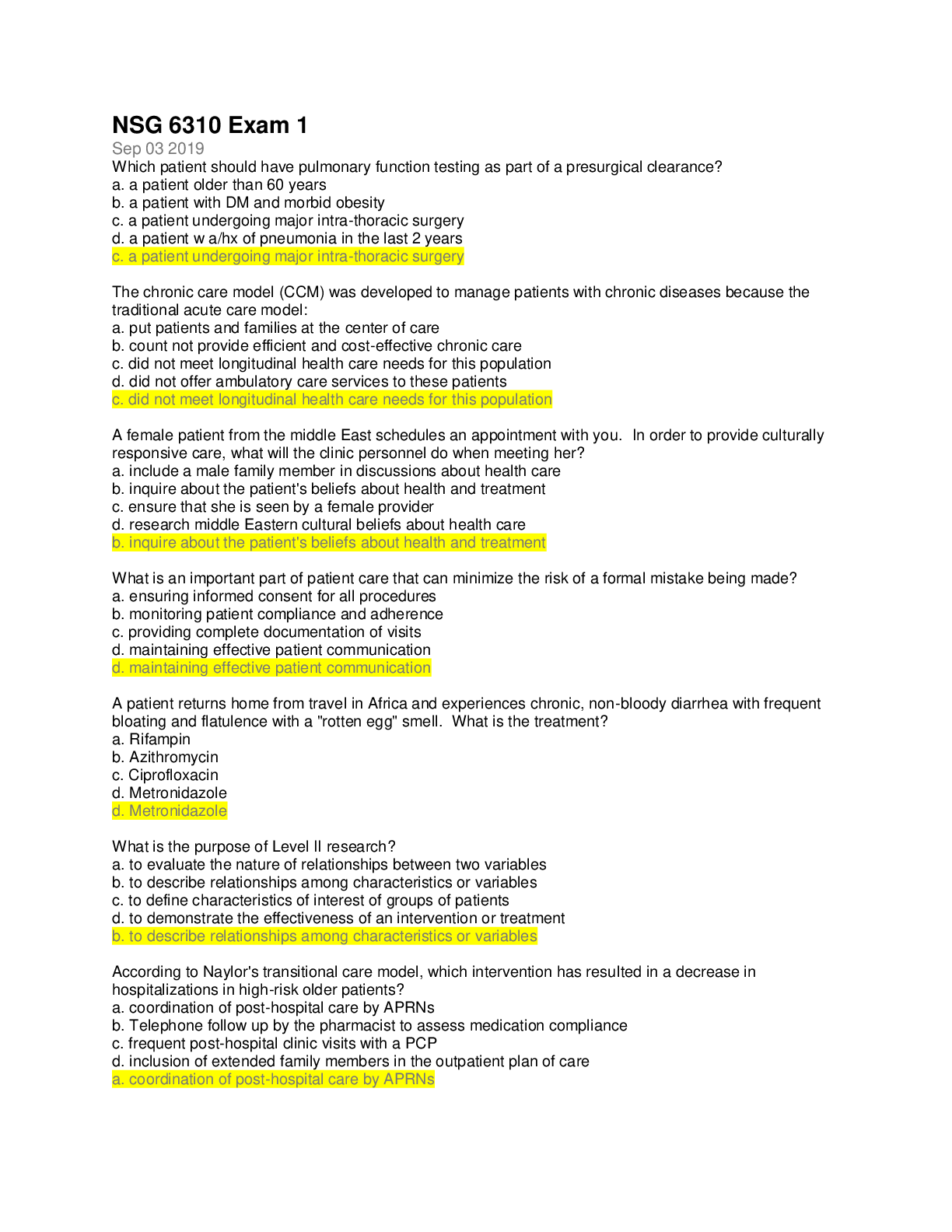
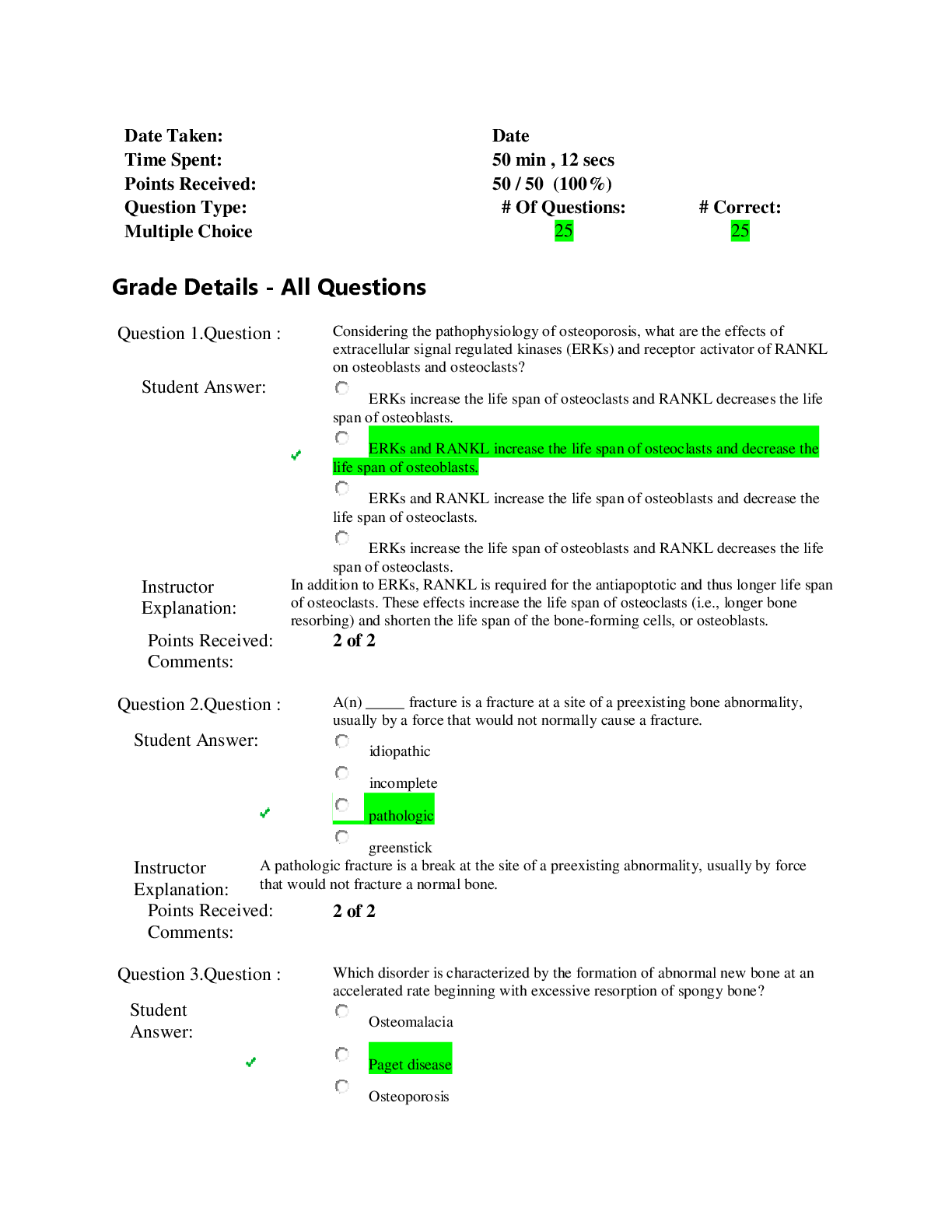

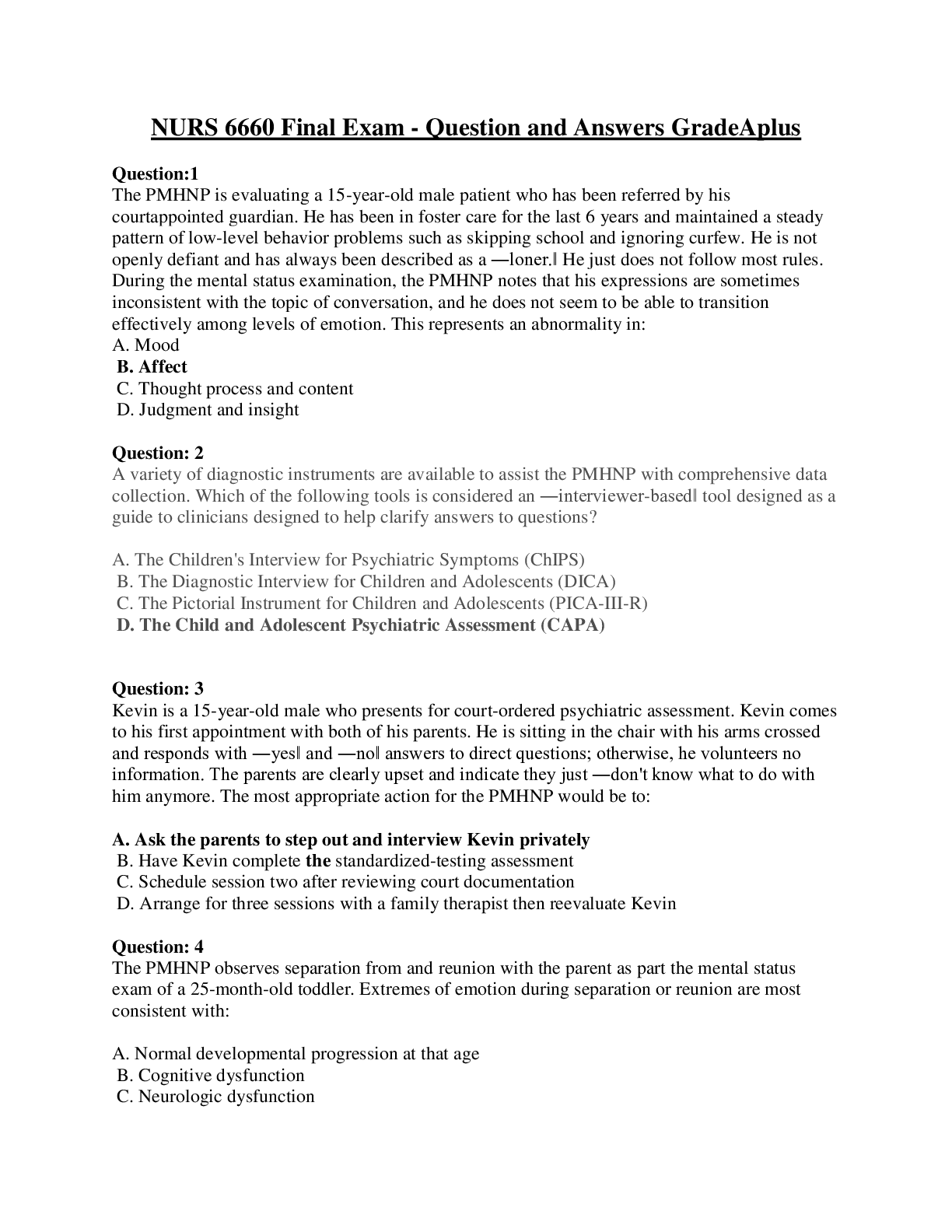

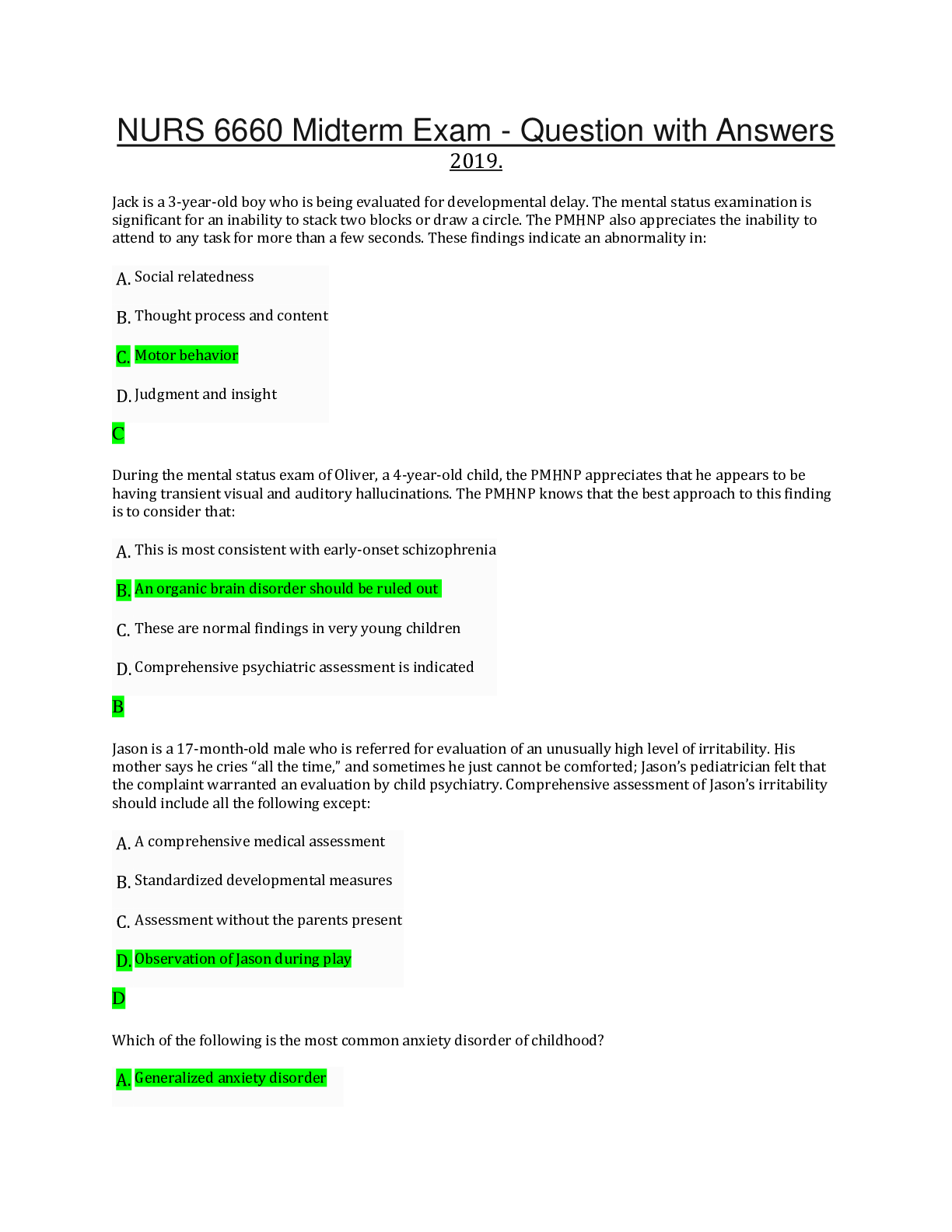

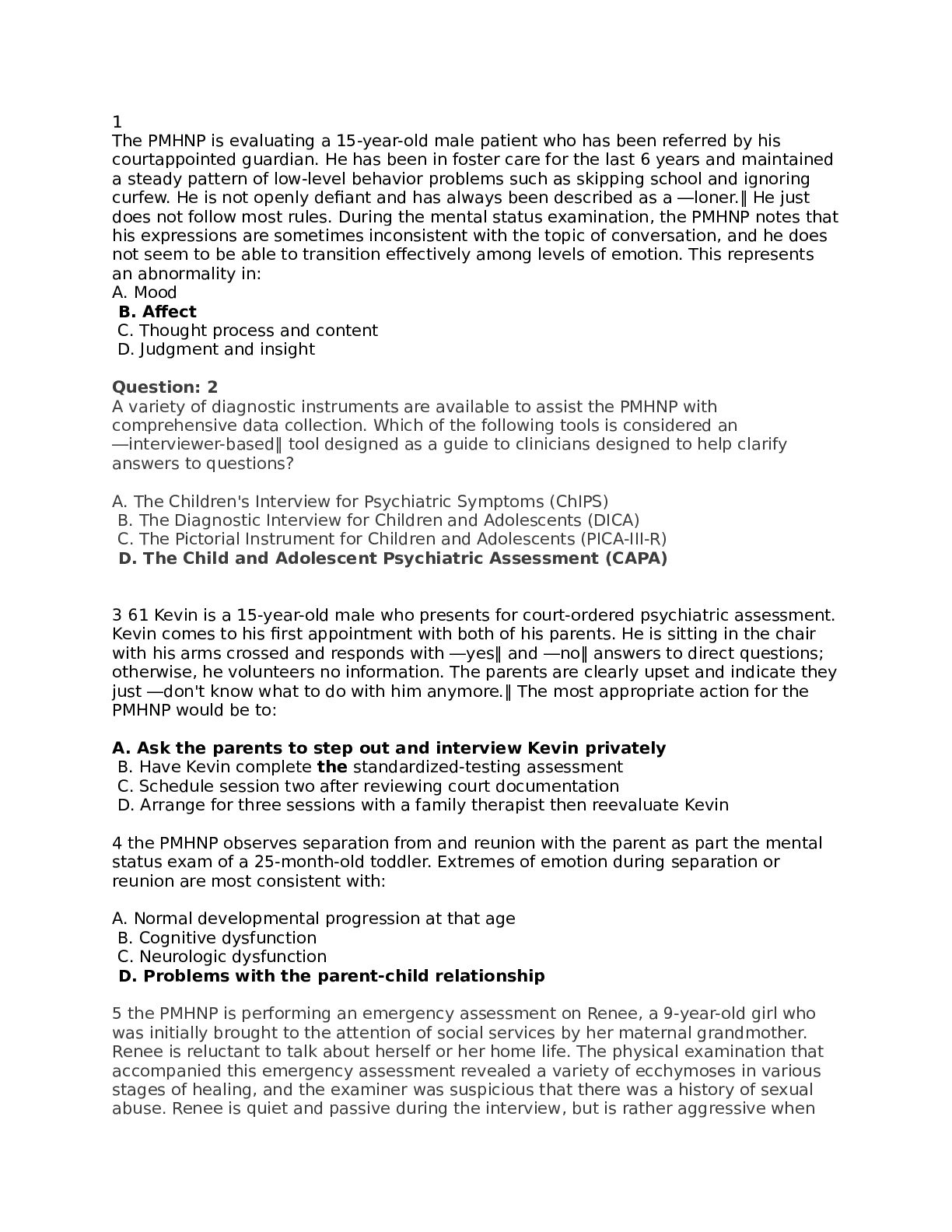
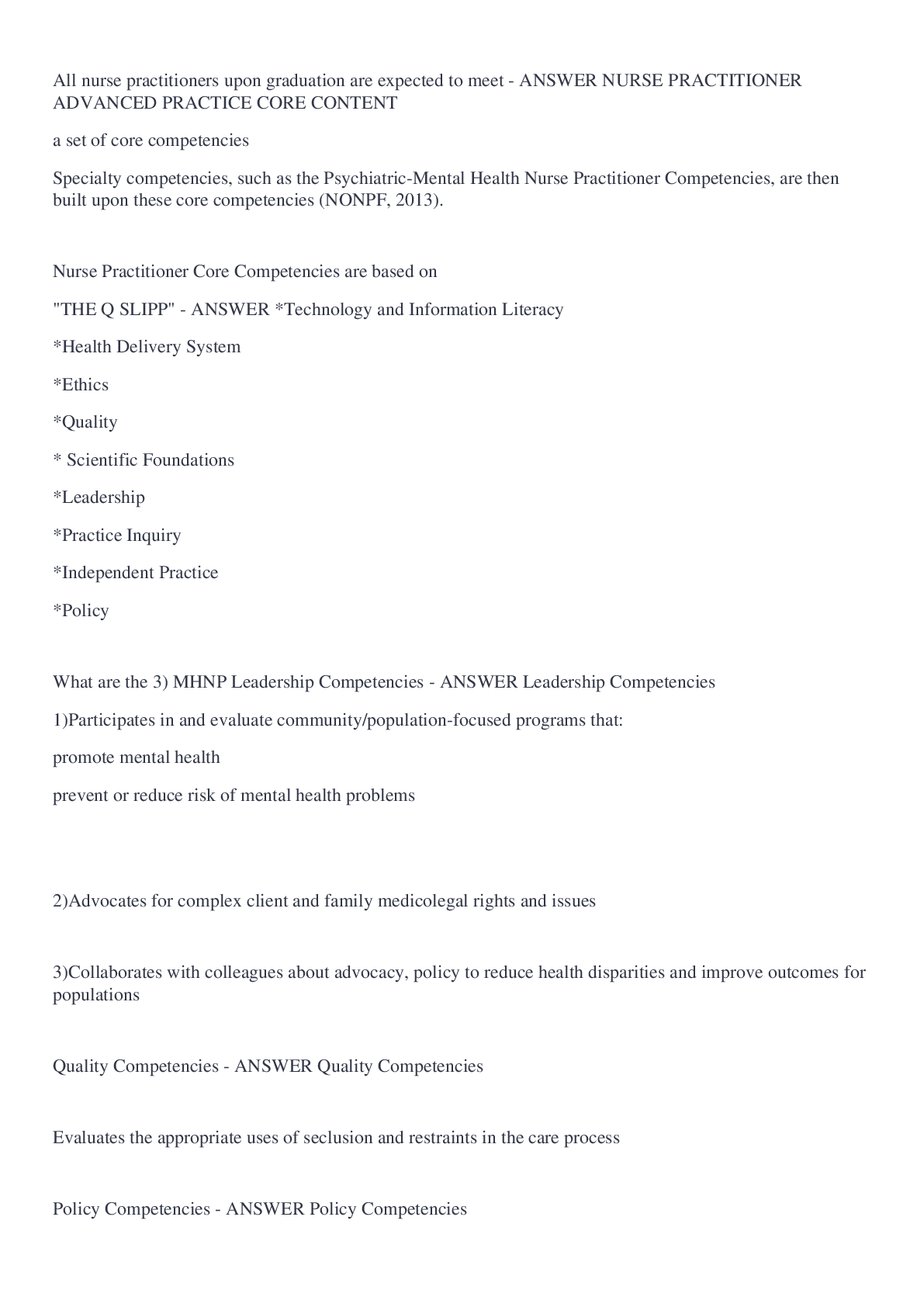
.png)
.png)



